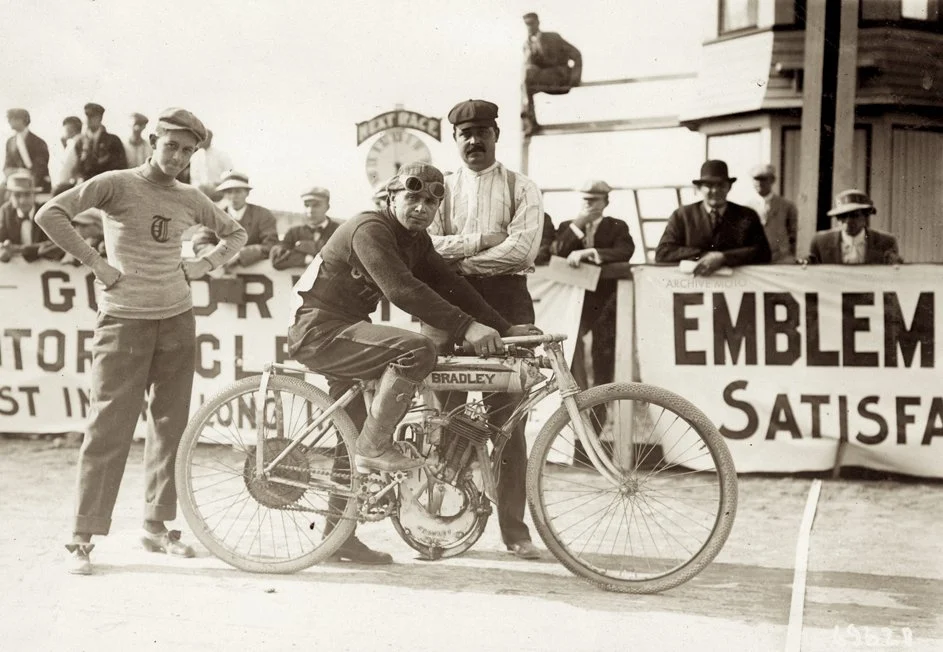Louis Steinhuaser onboard a 1911 Bradley, a special construction 500c side-valve racer at the F.A.M. National Championships in Fort Erie, Ontario on July 27, 1911. Behind Steinhuaser stands Charles E. Bradley, the founder of the innovative motorcycle company which had been in business since 1901.
Built on the back of a sprawling and booming bicycling industry when it first appeared, the early American motorcycle market quickly swelled with a number of manufacturers. At first, the industry was largely engine and component businesses, selling kits to adapt one’s bicycle into a motor-bike. Soon, an flurry of upstarts, innovators, and entrepreneurs began offering complete machines, some being preassembled kits, others being novel approaches to what a motorcycle could and should be. Hundreds of new motorcycle manufacturers emerged in the first decade, flooding the market and driving the technology and culture forward at a blistering pace. Among them were names that had perfected the recipe, names like Indian, Harley-Davidson, and Excelsior who balanced style, engineering, and marketing to dominate the industry and outlast the majority. Still, among the countless dozens of brands on offer for America’s earliest enthusiasts, several, like Bradley, the makers of this stout little racer from 1911, have been lost to time despite their significant innovations in their day.
Charles E. Bradley first opened his shop at 269 Diamond Street in Philadelphia in 1901, running advertisements for an array of motorcycle components and bolt-on engines the following season. In 1904, Bradley began offering complete, Bradley-branded single-cylinder motorcycles as a special order from the shop. The machines were simple and similar to many early motorcycles, though the Bradley was host to numerous innovative features from the start. Instead of a traditional bicycle-style diamond frame, Bradley offered a loop-style cradle frame. Mechanically operated valves, chain drives, and combination controls for spark and compression soon followed. Perhaps most notable, however, was the 1904 Bradley Model C, which featured the first production side-valve or flathead engine configuration in the United States. Another unique feature of the Bradley was the transversely oriented camshaft, which was mounted across the top of the crankcases making the marque easily recognizable.
Bradley himself was an avid motorcyclist, belonging to the local motorcycle club in Philadelphia and participating in cross-country tours and endurance competitions as early as 1905. Bradley may not be a household name today, but in his time, he was running against other sporting industry men that would be; pioneers like Walter Davidson, Oscar Hedstrom, Joseph Merkel, and Glenn Curtiss. Bradley soon began losing position to motorcycling’s early magnates as they continued to increase the scale of their manufacturing efforts. Still, the small and elegant brand out of Philadelphia continued to develop its machines both for the road and the track. In 1908, Bradley produced a special machine using his 3.5 horsepower, 500cc side-valve engine tailored for a unique rider. The engine was set into a rigid, extremely short wheelbase and was assembled for local stunt performer E.J. Develo. Later, in 1911, Bradley revised the stunt bike he had built for Develo to be used on the track, with a few lucky riders being selected to ride it.
Louis Steinhuaser was a fellow member of the Philadelphia Motorcycle Club and a fixture in any competition he could work his way into. Impressed by the young jockey, Bradley approached Steinhauser to ride one of his machines at the club’s races frequently held at the Point Breeze horse track on May 23, 1908. In his debut race, Steinhauser made the podium in every event, beating Indian’s seasoned speedster Stanley Kellogg and placing first in the 5-mile novice, second in the 10-mile and Australian pursuit events, and third in the unrestricted class. Later that same year, Steinhuaser rode a Bradley in a FAM 354-mile endurance competition and, had he not been bested by a roadside boulder, had a run at prevailing over the run’s eventual winner, Walter Davidson. Steinhauser would continue to race for Bradley, along with Bill Hollenback, until 1914.
This photograph was taken during the FAM National Championship races on July 27, 1911, and features Steinhauser mounted atop his unique side-valve Bradley. Though the machine has twin spark plugs, it was not a dual ignition machine; instead, the second was simply a spare placed into a special casting in the head. The man behind the company, Charles Bradley, stands confidently behind Steinhuaser, and the young man with the equally stern gaze standing alongside may be one of Bradley’s five sons. At the Fort Erie races, Steinhauser was up against icons in the sport, names like Morty Graves, Eddie Hasha, Charlie Balke, Johnny Constant, Lee Taylor, and Erwin Baker. Indian’s Frank Hart, onboard Springfield’s latest 8-valve racer, took the lion’s share of the honors, leaving Steinhuaser and his mighty Bradley little to show for the weekend’s effort.
As for the brand, Bradley soon joined the overhead-valve ranks with its own 4-valve single in 1912, as raced by Bill Hollenback, remaining on the cutting edge of innovation despite being one of the smallest manufacturers at that point. Ultimately, like so many early American motorcycle makers Bradley couldn’t compete with the scale the industry grew to and shut down production that same year. For a time, Bradley motorcycle embodied the spirit of American motorcycling in its formative years— a brand built from scratch during the creation of a culture, dedicated to spending life in the wind and running elbow to elbow with legends.
Interested in helping keep this remarkable history alive consider joining the Archive Moto Patreon page at Patreon.com/TheArchiveMoto.

